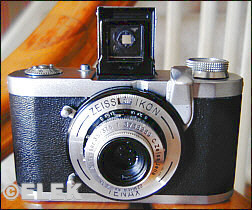Tenax (East Germany)

|
|
|
| Style, film format | Zone-focus, 24mm x 24mm on 35mm film |
|
|
|
| Lens, shutter | Coated f/3.5 37.5mm Tessar, leaf shutter |
|
|
|
| Photo quality | Very good |
|
|
|
| Ergonomics | Small body, front-mounted shutter release |
|
|
|
Zeiss Ikon followed the Tenax II with the Tenax I. I don't know why they named the first camera II and the second camera I and not III. The Tenax II made sense, because it was a resurrection of the original Tenax -- a camera made by Goerz, one of the companies that formed Zeiss Ikon.
But I suppose Zeiss Ikon didn't want to call the simpler model a Tenax III, because a higher number often signified a more complex model with such so-called premiums as rangefinder focusing or interchangeable lenses, and the Tenax I wasn't. In any case, there it is.
As with many stories involving the division of Zeiss Ikon, the tale of this camera has yet another twise. West German Zeiss Ikon did not restart production of the Tenax. East German Zeiss Ikon, however, made this little camera as well as several successor models, including the Taxona.
As you can see, I'm simply calling this Tenax, because this is a postwar camera from East Germany. I suppose it could be called a Tenax Ia, though from what I've read, East German Zeiss Ikon simply called it Tenax. I guess you could have argued that they could call it Tenax III or Tenax IV, but I'm glad they didn't.
This particular model is nearly identical to the prewar model, featuring the same rapid-wind lever, flip-up viewfinder and body style of the prewar models. The Zeiss Ikon logo is embossed into the leather on the camera back, which leads me to think that perhaps the camera was made not longer after the end of World War II.
Perhaps it was constructed from leftover materials. We'll never really know.
The leather case, however, features the Ernemann tower that became associated with Pentacon, even though the camera is marked as Zeiss Ikon. It's the prewar style case with a small rectangular bracket around the tripod locking screw.
The only difference from the prewar models is that it has a coated f/3.5 37.5mm Jena Tessar lens; the prewar Tenax I came with only the Novar. It's a unit-focusing lens, which means the entire lens is used to focus, rather than just the front element. In theory, this should give better performance throughout the focusing distance.
Its small body and rounded ends provide for a very comfortable camera that easily slips into a pocket. The viewfinder, which looks like it was taken from the 6x6 camera-parts bin, works well enough, and the 37.5mm lens offers enough depth of field to compensate for minor focusing errors.
In all, it's a nice little camera, which has proved to be a very capable shooter.
